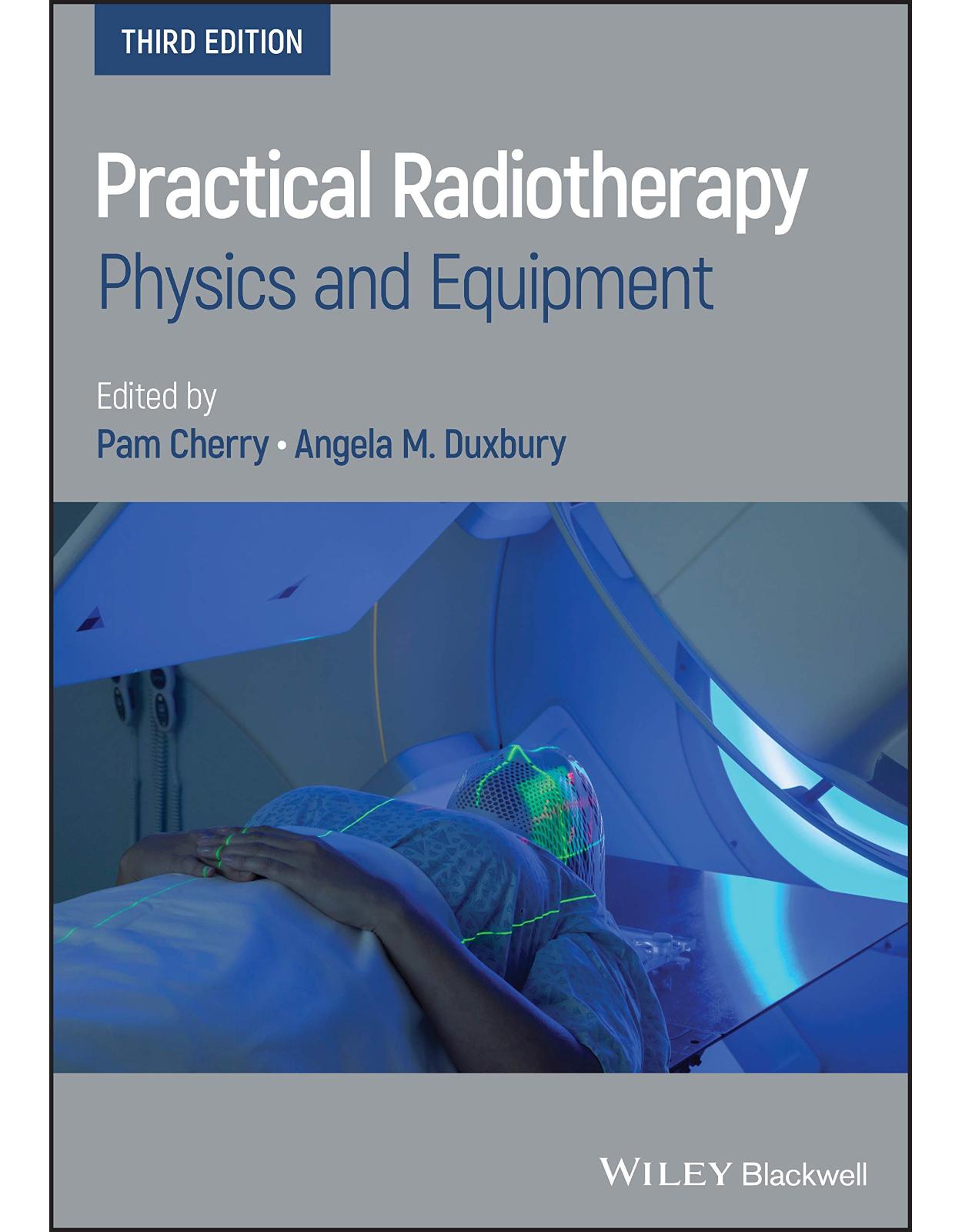
Practical Radiotherapy: Physics and Equipment, 3rd Edition
Livrare gratis la comenzi peste 500 RON. Pentru celelalte comenzi livrarea este 20 RON.
Disponibilitate: La comanda in aproximativ 4 saptamani
Editura: Wiley
Limba: Engleza
Nr. pagini: 328
Coperta: Hardcover
Dimensiuni: 17.78 x 1.78 x 25.15 cm
An aparitie: 2019
Description:
Now in its third edition, Practical Radiotherapy continues to keep pace with current and emerging technologies, patient pathways, and the rapidly expanding role of therapeutic radiographers.
Extensively revised and updated, this accessible book examines all the essential aspects of radiotherapy, from the physics and mathematics of radiation beams, to in-depth descriptions of the equipment used by radiotherapy practitioners, to new and expanded coverage of MR-linac and Halcyon technology, proton therapy, stereotactic body radiotherapy, sealed-source verification and quality assurance for MV equipment.
Covers all the core information essential to radiotherapy practice
Describes the major aspects of therapeutic radiography in a practical context
Includes updated self-assessment tests, images and diagrams, supplemental reading suggestions and more radiotherapy-specific examples
Features expanded coverage of legislation, advanced treatment delivery, flattening filter free treatment and more
Practical Radiotherapy is a valuable resource for radiotherapy and medical physics students, radiotherapists, therapeutic radiographers, radiation therapists, clinical oncologists and oncology nurses.
Table of contents:
Acknowledgement of Previous Contributors
CHAPTER 1: Introduction to Radiotherapy Practice
1.1 Introduction
1.2 What Is Radiotherapy?
1.3 Working with Ionising Radiations
1.4 How Radiotherapy Works
1.5 Radiotherapy Beam Production
1.6 Treatment Delivery and Planning
1.7 Treatment Accuracy and Patient Immobilisation
1.8 Technology and Techniques
1.9 Current Radiotherapy Practice
References
Further Reading
CHAPTER 2: Mathematical Skills Relevant for Radiotherapy Physics, Atomic Structure, and Radioactivity
2.1 Mathematical Skills Relevant for Radiotherapy Physics
2.2 Basic Physics Relevant to Radiotherapy
2.3 Heat and Temperature
2.4 Electricity, Magnetism, and Electromagnetic Radiation
2.5 The Electromagnetic Spectrum
2.6.4 Electron Orbits
2.6.5 Atomic Energy Levels
2.7 Classification of Nuclides
2.9 Background Radiation
Further Reading
CHAPTER 3: X‐ray Production
3.1 Introduction
3.2 The X‐ray Tube
3.3 X‐ray Production
3.4 X‐ray Output Intensity
3.5 Beam Quality
3.6 Factors Affecting the Output Intensity and Quality of the Beam
3.7 X‐ray Production and Clinical Practice
Further Reading
CHAPTER 4: Radiation Detection and Measurement
4.1 The Unit of Absorbed Dose
4.2 Free‐Air Ionisation Chamber
4.3 Cavity Chamber (Cylindrical or Thimble Chamber)
4.4 Parallel Plate (Pancake) Chambers
4.5 Air Kerma
4.6 Dosimetry of Megavoltage Photons
4.7 Radiation Detection and Measurement
4.8 Thermoluminescent Dosimeters
4.9 TLD Detector Types
4.10 Optically Stimulated Luminescence (OSL) Dosimetry
4.11 Dosimetry in CT
4.12 MRI LinAc
References
Further Reading
CHAPTER 5: X‐ray Interactions with Matter
5.1 Introduction
5.2 X‐ray Interaction Processes
5.3 Electron Interactions and Ranges
Further Reading
CHAPTER 6: Principles of Imaging Modalities
6.1 Introduction
6.2 2D Imaging
6.3 Plain Radiography Image Generation
6.4 CT
6.5 MRI
6.6 Ultrasound
6.7 PET
6.8 Image Registration, Image Fusion, and Multimodality Imaging
6.9 Hybrid and Functional Imaging
6.10 Future Perspectives of Pre‐treatment Imaging
References
Further Reading
CHAPTER 7: Principles of Treatment Accuracy and Reproducibility
7.1 Introduction
7.2 Scanner Aperture Size
7.3 Reference Points and Anatomical Landmarks
7.4 Treatment Tattoos Versus Semipermanent Skin Marks
7.5 Lasers and Treatment Setup
7.6 Volume Definitions and Target Defining Concepts
7.7 Treatment Bolus and 3D Bolus Printing
7.8 Immobilisation Shells
7.9 Immobilisation Equipment for Head and Neck Treatment
7.10 Immobilisation Techniques and Proton Beam Radiotherapy
7.11 Immobilisation Equipment for Breast Treatment
7.12 Respiratory Movements
7.13 Thorax Immobilisation
7.14 Immobilisation Equipment for Pelvic Treatment
7.15 Superficial Radiotherapy
7.16 Position Reproducibility in Emergency or Palliative Radiotherapy
7.17 Immobilisation for Less Common Techniques
7.18 Immobilisation Equipment for Treatment of Extremities
7.19 Immobilisation of the Paediatric Radiotherapy Patient
7.20 Stereotactic Radiotherapy
7.21 Conclusion
Acknowledgements
References
Further Reading
CHAPTER 8: Radiotherapy Beam Production
8.1 Introduction
8.2 Kilovoltage Equipment
8.3 Superficial and Orthovoltage Equipment
8.4 Inverse Square Law
8.5 Quality Assurance Tests
8.6 Linear Accelerators
8.7 Production and Transport of the RF Wave
8.8 Ancillary Equipment
8.9 Treatment Head
8.10 Patient Support System
8.11 Imaging Systems
8.12 Other Linear Accelerator Designs
8.13 Quality Assurance of a Linear Accelerator
8.14 Cyclotrons and Proton Beams
8.15 Gamma Knife
8.16 Intraoperative Radiotherapy
8.17 Treatment Delivery Techniques
Acknowledgements
References
CHAPTER 9: Principles and Practice of Treatment Planning
9.1 Introduction
9.2 Treatment Planning Principles
9.3 ICRU Guidelines
9.4 Treatment Planning Objectives
9.5 Treatment Planning Process
9.6 Advanced Treatment Planning
9.7 Quality Assurance
References
CHAPTER 10: Image‐guided Radiotherapy and Treatment Verification
10.1 Introduction
10.2 Fundamental Principles of Treatment Verification
10.3 Site‐specific Uncertainties and Protocols
10.4 Record and Verify Systems and Computer‐Controlled Delivery
10.5 Conclusion
References
CHAPTER 11: Quality Management in Radiotherapy
11.1 Introduction
11.2 What Is Quality?
11.3 Quality Assurance and Quality Control
11.4 Quality Management
11.5 QMS
11.6 ISO 9000
11.7 The Radiotherapy QMS
11.8 Document Control
11.9 Concessions and Non‐conformances
11.10 Clinical Governance
11.11 Risk Management
11.12 Risk Assessment
11.13 Reducing Risk
11.14 Clinical Incidents: Reporting and Learning
11.15 Why Is it Important to Report?
11.16 Clinical Audit
References
CHAPTER 12: Radiation Protection
12.1 Dangers of Ionising Radiations
12.2 Rationale for Radiation Protection
12.3 Radiation Protection in Practice
12.4 Radiation Protection by Design
12.5 Personal Monitoring
12.6 Radiation Protection Legislation
12.7 Radiation Protection Organisations
12.8 IR(ME)R 2018
12.9 IRR 2017
References
CHAPTER 13: The Use of Radionuclides in Molecular Imaging and Molecular Radiotherapy
13.1 Introduction
13.2 Radionuclides
13.3 Imaging Equipment
13.4 Single Photon Emission Computed Tomography (SPECT)
13.5 Positron Emission Tomography (PET)
13.6 Hybrid Imaging Systems
13.7 Radiopharmaceuticals
13.8 Tumour (Molecular) Imaging and Molecular Radiotherapy (MRT)
13.9 Radiation Protection Related to Radioactive Substances
13.10 Dosimetry
References
CHAPTER 14: Brachytherapy Physics and Equipment
14.1 Introduction
14.2 The Journey from Live Loading to Remote Afterloading
14.3 Brachytherapy Terminology
14.4 The Impact of Dose Rate
14.5 Afterloading Equipment
14.6 HDR Afterloaders
14.7 Brachytherapy Dosimetry
14.8 Transfer of Information to the Treatment Unit and Checking of Data
14.9 Principles of Safe Treatment Delivery
14.10 Treatment Protocols in Brachytherapy
14.11 Clinical Examples
14.12 Conclusion
References
Index
End User License Agreement
| An aparitie | 2019 |
| Autor | Pam Cherry, Angela M. Duxbury |
| Dimensiuni | 17.78 x 1.78 x 25.15 cm |
| Editura | Wiley |
| Format | Hardcover |
| ISBN | 9781119512622 |
| Limba | Engleza |
| Nr pag | 328 |



Clientii ebookshop.ro nu au adaugat inca opinii pentru acest produs. Fii primul care adauga o parere, folosind formularul de mai jos.